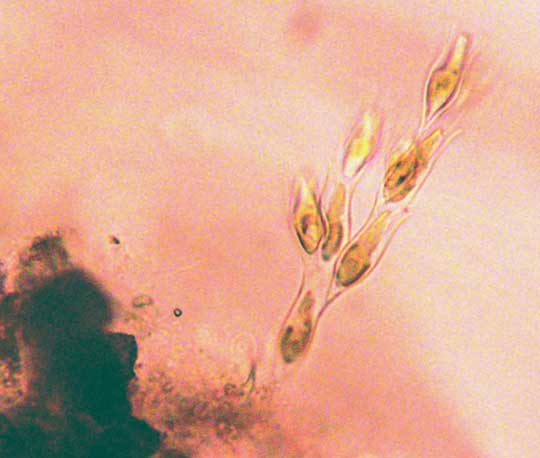Excerpts from Jim Conrad's
Naturalist Newsletter
from the March 24, 2013 Newsletter issued from the valley of the Dry Frio River in northern Uvalde County, southwestern Texas, on the southern border of the Edwards Plateau; elevation ~1750m (~5750 ft); N29.62°, W99.86°; USA
DINOBRYON, A GOLDEN ALGA
During this week's safari into a drop of water from the little Dry Frio River behind the cabin, I came upon a speck of debris suspended in the water. A treelike structure of a kind I'd never seen before arose from the debris, slowly undulating in microscopic currents like a large elm tree in a lazy summer breeze, as shown below:

The entire branched structure was about 250 microns long, or 0.25mm, or 1/100th of an inch. I had no idea where to begin with the identification process, but by using a search engine image-search feature and the keywords "freshwater microscopic branched," after only three or four pages of thumbnail images I saw our unknown. To my vast surprise it turned out to be an alga, very unlike the filamentous or one-celled, freely floating algae species we've seen until now. Judging from pictures and lists of algae found in our area, I'm thinking our branched alga is a member of the genus DINOBRYON, though I wouldn't say which species. Dinobryon divergens appears to be especially common in our area, and looks like ours, so that name would be a good educated bet.
The genus Dinobryon is described as comprising species of freshwater algae forming colonies. In Dinobryon, each vaselike section of the branching colony is known as a "lorica," which is defined as a tubular, conical, or vaselike structure secreted by some protozoans and many rotifers. Each lorica contains a flattened, yellow-brown, photosynthesizing chloroplast, clearly visible in our image. When the alga cell inside its lorica divides, it rises to the rim of its lorica, grows a new lorica, and this is how the colony grows. If a lorica or group of loricae become detached from the colony, it can start a new colony.
Dinobryon photosynthesizes its own food, but under low light conditions can feed on bacteria and diatoms. Watching our Dry Frio colony sway back and forth, it seemed that its loricae were filtering the water in search of such food.
Dinobryon is one genus of about 33 genera included in the Golden Algae Family, the Chrysophyceae. Golden algae are capable of releasing toxins that affect gill-breathing aquatic organisms such as fish and clams. Golden algae grow rapidly and can out-compete other algae for nutrients, causing "blooms" during which enough toxins are released to kill fish and other gill breathers. The toxins cause fish gills to bleed and lose their ability to absorb oxygen, so the fish die of asphyxiation.
A 2011 report out of Baylor University states that along the Brazos River in north and central Texas, at least seven million fish have been killed since 1988 due to high golden algae levels. In 2005 more than a million fish died in Lake Whitney over a three-month period.